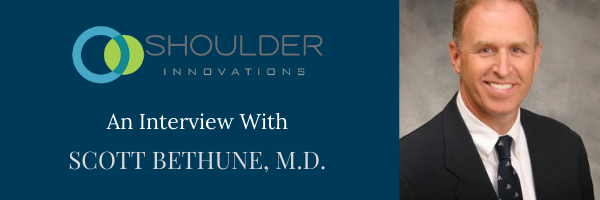We recently had the opportunity to meet with Scott Bethune, MD, specifically to talk about his background and his experiences using the InSet™ Glenoid from Shoulder Innovations.
Dr. Scott Bethune is an Orthopedic Surgeon in Stockton, California.
David Blue: Dr. Bethune, would you please share your background with us, including how you became involved in healthcare and specifically orthopedics?
Dr. Bethune: I was born and raised in Canada. I discovered orthopedics after blowing out a knee in high school football. I spent a year recovering from ACL surgery in 1977 (fortunate for me, my mother is a nurse). That experience changed my life.
I became aware of the advances occurring in Orthopedic Surgery and Sports Medicine, and I decided that seemed like a pretty good career. To my great fortune medical school, residency, and fellowship doors kept opening when I knocked.
Along the way, I met spectacularly motivating and innovative surgeons who served as mentors. I had the privilege of working with some special people. The relevance, importance, and value of what Orthopedic Surgeons contribute to society was repeatedly emphasized. Living up to the standard is a heavy responsibility.
David Blue: What was it that attracted you to the shoulder as a sub-specialty?
Dr. Bethune: Honestly, that was from exposure to Dr. Richard Hawkins. He was the Surgeon we trained under for shoulder surgery in London, Ontario. He was such an inspirational educator. He also helped to arrange fellowship training for me in Australia. Dr. Hawkins was a mentor professionally, academically, and personally. I would drive him to Grand Rounds once in a while when he lived just around the corner.
David Blue: How did you first learn about the Shoulder Innovations InSet™ Glenoid, and the Shoulder Innovations team?
Dr. Bethune: Well, I knew most of the principles from when they were with previous companies. I knew their heritage. I knew the quality of their character, and I knew their capabilities.
I’ve always valued relationships with good people. When good people come to you with what they’re currently passionate about, it is wise to listen. I learned about the Shoulder Innovations team, and I was intrigued by what they had to say about the InSet™ glenoid.
David Blue: What were your initial impressions of Shoulder Innovations and the concept of the InSet™ glenoid?
Dr. Bethune: At first glance, I wasn’t certain whether or not we should trust that glenohumeral joint stability would be maintained. The dimensions of the implant look to be smaller than most others currently on the market.
I talked to some folks who were already using it, and they had experienced no sign of instability whatsoever. I tried it on a few simple cases, and the early results were very impressive. The fixation was also rock solid.
From there I expanded the indications to some anatomically problematic glenoids, and it’s continued to prove itself rock solid.
David Blue: What types of indications do you primarily use this system with?
Dr. Bethune: Assuming the rotator cuff is intact, osteoarthritis is the primary indication for the Shoulder Innovations’ InSet™ total shoulder replacement system.
I’m selective in choosing when to perform hemiarthroplasty as I’m not a “ream and run” advocate. I trust that I see more reproducible pain relief quicker and more reliably with an implanted glenoid.
David Blue: If you were sitting down with a fellow surgeon to talk to them about this technology for the very first time, what would you tell them?
Dr. Bethune: It’s straightforward to use. You can trust when it’s implanted – it’s not going anywhere. It’s not moving or migrating.
On the humeral side, I really like the InSet™ Humeral Short Stem component, as it sure seems to me, that there is less bone that is being removed with this stem, than with others I have used. It’s very much a proximal load-sharing device, and you’re not required to excavate anywhere near the same volume of cancellous bone that you are with the majority of other humeral implant systems on the market.
David Blue: Do you have any tips or pieces of advice that you would give other surgeons if they were using the system for the first time?
Dr. Bethune: Well, a shoulder surgeon might tend to look at the circular shape of the InSet™ glenoid and expect to implant it the same way as the circular base plate of a reverse total shoulder, whereas optimum positioning is different in an anatomic shoulder than in a reverse.
It’s important to understand what your objective is before you start. I use 3D imaging preoperatively for the majority of my cases. I find it helpful to pick the starting point, and to plan before I put the patient asleep — especially when doing a significant B2 or B3 glenoid with significant deformity.
I’ve had the opportunity to remove a couple of InSet™ glenoids. One for infection, which sadly is going to happen from time to time. The other was in the setting of a rotator cuff failure that was not repairable. And I can tell you that taking them out is eye-opening. They were in there as securely as the day that they were implanted!
Lastly, the Shoulder Innovations team has done an excellent job of keeping the tray so streamlined and simple. The system is really well engineered. Relatively simple instrumentation makes it easier for everyone in the OR, which helps when your exploring new techniques.

